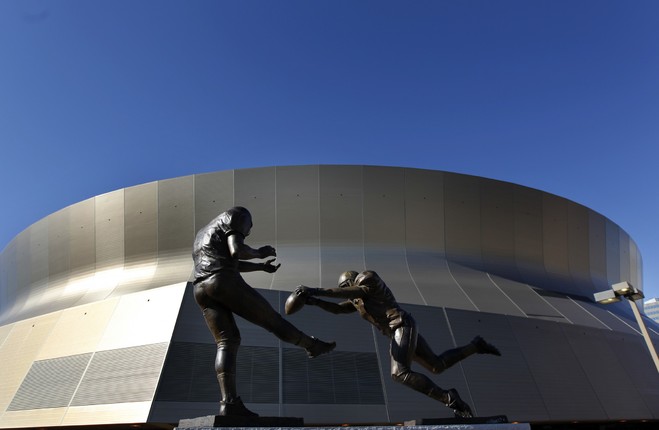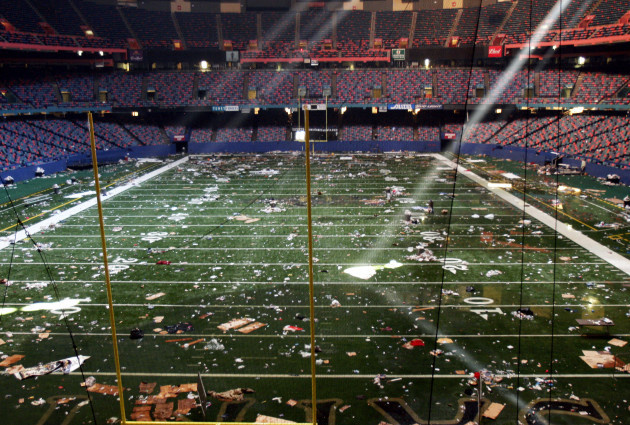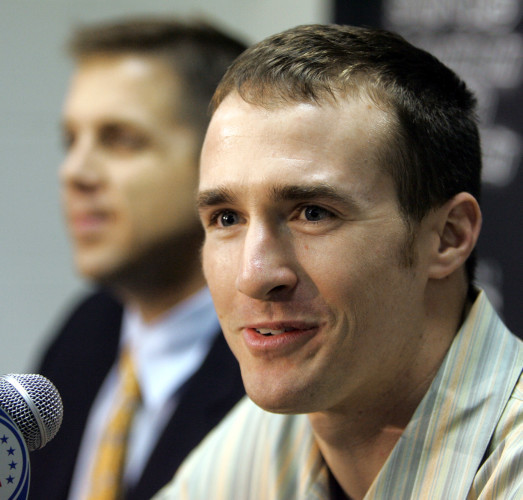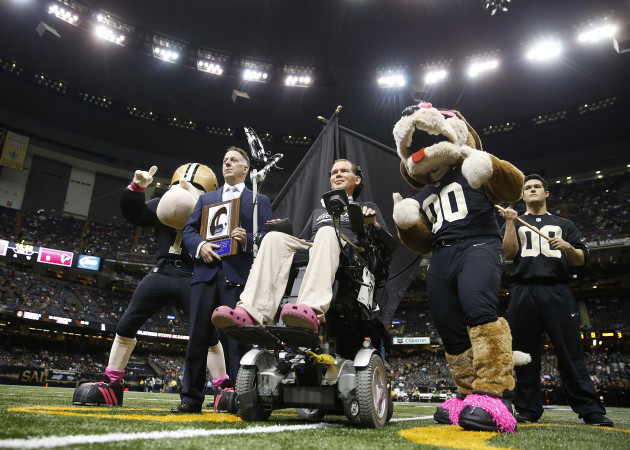MANY IRISH AMERICAN football fans may have missed the most important play in New Orleans Saints history. No, it wasn’t one of Drew Brees’s 433 touchdown passes. It wasn’t even Thomas Morstead’s Super Bowl XLIV-changing onside kick.
Instead, the franchise-defining play happened on the first drive of a regular season Monday Night Football game between the Saints and their divisional rivals, the Atlanta Falcons.
The play-by-play will read something like: ATL: Punt (M Koenen), BLKD (S Gleason), REC NO (C DeLoatch) TD. 6-0 NO.
But as a symbol for the city, residents of Big Easy prefer to refer to it by one word:
Rebirth.
To understand what made the play so important, however, you need cast your mind back even further, to late August 2005 when the fifth named storm of the Atlantic hurricane season made landfall in the United States.
Hurricane Katrina was one of the top five deadliest on record in the US with 1,883 people losing their lives. It was the third most powerful storm in US history with winds of 280kph. It was also — though what does this really matter when so many people died — the costliest, with no less than $108 billion worth of damage left in its wake.
In the hours before the storm hit, before the levees broke and the floodwaters rose, thousands of residents of the city made the familiar trek to the Louisiana Superdome on 1500 Sugar Bowl Drive. But it was not to watch football.
Built in 1975 as a sports and exhibition centre, the Superdome was also the designated ‘shelter of last resort’ for the residents of New Orleans with nowhere else to turn.
So on 28 August, 2005, 14,000 people — plus 550 members of the National Guard — turned up for refuge.
The reason for the National Guard was because most of the regular Superdome staff had been evacuated from the city leaving just 18 staffers to run the facility. They were also employed to stop guns, knifes and other weapons from entering the building.
It was not the first time the building had been used for such a purpose. Indeed, just a year earlier, when Hurricane Ivan struck the city, a similar number of people sought temporary shelter in the building.
However, Katrina was different and though there were claims the design of the structure meant it could survive winds of up to 300kph, no engineering study was ever conducted to test their veracity.
None needed to be conducted. By 9am local time on 29 August, 2005, reports were coming in that parts of the roof had peeled off and rain was leaking into the stadium.
That didn’t stop more residents from arriving and seeking shelter and while there’s no official number, estimates of the total number who made the Superdome a temporary home over the next few days range from 15,000 to 40,000.
Pictures from the stadium are reminiscent of a zombie apocalypse and as more and more people tried to gain entry to the landmark, there were reports of muggings, rapes and deaths.
Even at a remove of 11 years, separating fact from fiction as to what happened in and around the Superdome is difficult but, what was certain, was that the facility would need a lot of work before it could be used by the Saints again.
Rumors swirled that the damage was so bad that majority owner Tom Benson might just knock the Superdome and move the Saints elsewhere.
Indeed, the San Antonio Express-News went as far as reporting that the Benson family planned to void the lease agreement with New Orleans by declaring the Superdome unusable.
Ultimately, however, the Bensons decided to refurbish the facility and though it was out of action for the entire 2005 season, it was ready for 2006 and their home opener against the Atlanta Falcons on 25 September.
New start
In 2005, the Saints recorded just three wins and 13 losses and parted company with head coach Jim Haslett before appointing Dallas Cowboys quarterback coach Sean Payton to the job.
There was also a change at quarterback for New Orleans as they brought in free agent Drew Brees to replace the ineffective Aaron Brooks and Todd Bouman.
The season started with a nervy enough win over the Cleveland Browns on the road before beating the Green Bay Packers at Lambeau Field to give Saints fans reason to believe that 2006 would see a turnaround in fortunes.
Everything that year was geared towards the re-opening of the Superdome though, and the match-up against the Falcons.
Indeed, just before the game, the team announced that, for the first time in franchise history, it had sold out its entire allocation of home tickets for the season.
As kick-off approached, Green Day and U2 performed in the stadium and whipped the crowd up into a frenzy. It seemed to help the players too as, on third down of the very first drive, linebacker Scott Fujita stripped Falcons quarterback Michael Vick before the ball rolled out-of-bounds.
That forced the Falcons to punt and Gleason — a defensive back and special teams player — became a hero:
The moment just encapsulated the new-found belief in New Orleans that the city could rebuild around the Saints and they went all the way to the NFC Championship Game where they fell to the Chicago Bears.
Two seasons later, and the team without a home were Super Bowl champions.
However, the story is tinged with sadness.
Life-changing
Gleason’s time with the Saints came to an end after the 2007 season — meaning he missed out on their Super Bowl run — and he retired from football immediately afterwards.
In 2011, at the age of 34 and just before finding out he was about to become a father for the first time, Gleason was diagnosed with motor neuron disease (known in the US as Amyotrophic lateral sclerosis or ALS).
Far from giving up on life. Gleason was determined to raise awareness of the illness and to live his life to the fullest.
On top of embarking on expedition to Alaska, he created a foundation to help other ALS patients.
In collaboration with filmmaker Sean Pamphilon, he documented his battle with his illness for his son, Rivers, and that footage is to be released in a documentary this year called, simply, Gleason.
That process of making the documentary was not without controversy, however, as — in April 2012 — a 12-minute audio tape recorded by Pamphilon before a playoff game in 2011 became public.
It featured then-Saints defensive coordinator Greg Williams encouraging his charges to injure opposing players.
NFL Commissioner Roger Goodell responded to the Bountygate scandal with some of the most severe sanctions in the league’s history.
However, the people of New Orleans still treated Gleason as a hero and, in 2012, a bronze statue entitled ‘Rebirth’ was unveiled to honour his blocked punt:
As if to bring everything full circle, Gleason was guest of honour for the Saints when they met the Falcons in Thursday night football last season as the Pro Football Writers Association of America were set to present him the George Halas Award for the NFL coach, player or staff member who overcomes the most adversity to succeed.
During the game, this happened:
By a strange quirk of fate, the man who made the block that night — Michael Mauti — is a New Orleans native and the son of a former Saints player, Rich.
Not only that, but he actually attended the 2006 game where Gleason helped turn the fortunes of the city.
On Monday night. In the Superdome. The Saints and Falcons meet yet again to mark the 10th anniversary of ‘Rebirth.’
Can lightning strike three times?
You can see the trailer for ‘Gleason’ here:







